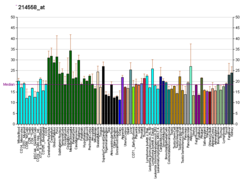Probable G-protein coupled receptor 12 is a protein that in humans is encoded by the GPR12 gene .[ 5] [ 6] [ 7]
The gene product of GPR12 is an orphan receptor , meaning that its endogenous ligand is currently unknown. Gene disruption of GPR12 in mice results in dyslipidemia and obesity.[ 8]
^ a b c GRCh38: Ensembl release 89: ENSG00000132975 – Ensembl , May 2017^ a b c GRCm38: Ensembl release 89: ENSMUSG00000041468 – Ensembl , May 2017^ "Human PubMed Reference:" . National Center for Biotechnology Information, U.S. National Library of Medicine .^ "Mouse PubMed Reference:" . National Center for Biotechnology Information, U.S. National Library of Medicine .^ Saeki Y, Ueno S, Mizuno R, Nishimura T, Fujimura H, Nagai Y, Yanagihara T (December 1993). "Molecular cloning of a novel putative G protein-coupled receptor (GPCR21) which is expressed predominantly in mouse central nervous system" . FEBS Letters . 336 (2): 317–22. doi :10.1016/0014-5793(93)80828-I PMID 8262253 . S2CID 31345248 . ^ Song ZH, Modi W, Bonner TI (July 1995). "Molecular cloning and chromosomal localization of human genes encoding three closely related G protein-coupled receptors" . Genomics . 28 (2): 347–9. doi :10.1006/geno.1995.1154 . PMID 8530049 . ^ "Entrez Gene: GPR12 G protein-coupled receptor 12" .^ Bjursell M, Gerdin AK, Jönsson M, Surve VV, Svensson L, Huang XF, et al. (September 2006). "G protein-coupled receptor 12 deficiency results in dyslipidemia and obesity in mice". Biochemical and Biophysical Research Communications . 348 (2): 359–66. doi :10.1016/j.bbrc.2006.07.090 . PMID 16887097 . ^ Brown KJ, Laun AS, Song ZH (November 2017). "Cannabidiol, a novel inverse agonist for GPR12" . Biochemical and Biophysical Research Communications . 493 (1): 451–454. doi :10.1016/j.bbrc.2017.09.001 . PMC 5849771 PMID 28888984 . ^ "GeneCards®: The Human Gene Database" .
Uhlenbrock K, Huber J, Ardati A, Busch AE, Kostenis E (2003). "Fluid shear stress differentially regulates gpr3, gpr6, and gpr12 expression in human umbilical vein endothelial cells". Cellular Physiology and Biochemistry . 13 (2): 75–84. doi :10.1159/000070251 . PMID 12649592 . S2CID 45156405 .




